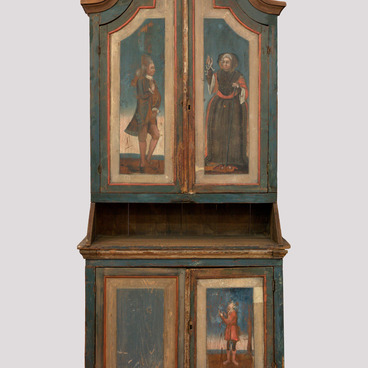Granted dippers are one of the most common forms of military and civil service awards. As a rule, such precious utensils were not used for their direct utilitarian purpose. Granted dippers were carefully kept as tokens of high merit and were inherited. Sometimes, along with other property, they returned to the royal treasury in case the owner fell into disgrace. In the event of the loss of the award bucket during a fire or other disaster, a person had the right, having asked for the permission of the tsar, to restore the bucket at his own expense.
In terms of the subtlety of execution and the technical perfection of the carving, the dipper of the burgomaster Golovkin can be attributed to the outstanding examples of decorative and applied art of the late 17th century. The inscription on the crown says that in 1702 Peter I awarded the burgomaster of Smolensk Mikhail Ivanovich Golovkin with this dipper ‘… for his many service and zeal and for the tax collection in the past 1701’.
In the Smolensk dipper, the use of the word ‘burgomaster’, which is new for the Russian language, is rather interesting. The post of burgomaster was introduced in Russia by Peter’s decree of January 30, 1699. The new official headed the city government. His duties included judicial and administrative-fiscal matters, and first — the collection of all taxes from the population, for which the burgomaster was responsible with his property. The inscription on the bucket confirms that Golovkin was awarded for good tax collection the previous year.
Several craftsmen worked on the creation of the dipper: a chaser, an engraver, a caster, a gilder and a scribe. The dipper was made in Moscow. The initials of the master “POG” are engraved on the bottom.
The dipper is made in the form of a boat. To give solemnity, part of the relief is gilded. The relief itself is made in the form of a decorative plant ornament with the heads of fabulous birds. Along the edge of the dipper there is a carved inscription, interrupted by medallions with the titles of the tsar. At the bottom, spout and handle there is an image of a two-headed eagle. State symbols were placed on precious dishes, as a rule, in two cases: if these dishes belonged to the reigning house or were intended to be a state award.
In terms of the subtlety of execution and the technical perfection of the carving, the dipper of the burgomaster Golovkin can be attributed to the outstanding examples of decorative and applied art of the late 17th century. The inscription on the crown says that in 1702 Peter I awarded the burgomaster of Smolensk Mikhail Ivanovich Golovkin with this dipper ‘… for his many service and zeal and for the tax collection in the past 1701’.
In the Smolensk dipper, the use of the word ‘burgomaster’, which is new for the Russian language, is rather interesting. The post of burgomaster was introduced in Russia by Peter’s decree of January 30, 1699. The new official headed the city government. His duties included judicial and administrative-fiscal matters, and first — the collection of all taxes from the population, for which the burgomaster was responsible with his property. The inscription on the bucket confirms that Golovkin was awarded for good tax collection the previous year.
Several craftsmen worked on the creation of the dipper: a chaser, an engraver, a caster, a gilder and a scribe. The dipper was made in Moscow. The initials of the master “POG” are engraved on the bottom.
The dipper is made in the form of a boat. To give solemnity, part of the relief is gilded. The relief itself is made in the form of a decorative plant ornament with the heads of fabulous birds. Along the edge of the dipper there is a carved inscription, interrupted by medallions with the titles of the tsar. At the bottom, spout and handle there is an image of a two-headed eagle. State symbols were placed on precious dishes, as a rule, in two cases: if these dishes belonged to the reigning house or were intended to be a state award.

